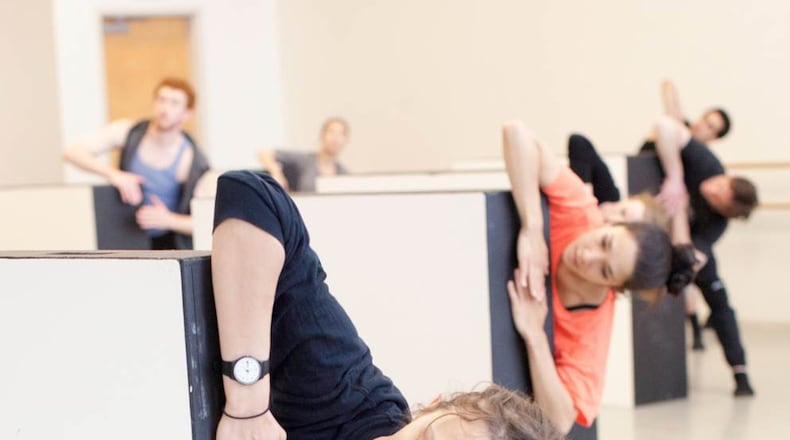Alexander Ekman's "Cacti" is many things that contemporary dance usually is not: lighthearted, whimsical, even silly.
The Swedish choreographer's work, one of three of-the-moment pieces on Atlanta Ballet's "Mayhem" program opening May 15 at Cobb Energy Performing Arts Centre, is a cheeky parody of modern dance's greater excesses.
The 2010 dance features grandiose narration that reveals the performers’ and choreographer’s deepest (but not deep) thoughts, immediately cluing audiences in on the work’s absurd tone. Its mind-bending lines include, “The genderless, anonymous, parallel bodies on the horizontal plain represent the absolute principles of heaven, man and earth.”
In addition to an orchestral score, a string quartet plays onstage, strolling amid the barefoot dancers, whose movement is energetic but sometimes intentionally something other than lyrical.
Adding to the thorny proceedings, the symbolic cacti of the title indeed appear on stage.
But while the work may be upbeat, it’s hardly laid back.
At a recent rehearsal at Atlanta Ballet’s Westside studios, Ekman’s stager, Ana Maria Lucaciu, was putting the entire company through challenging paces. “Cacti” is a large, vignette-filled ensemble piece performed by 16. But 20 company members, plus two apprentices and three fellowship dancers, were crowded into the studio learning it — and pronto.
The dancers were trying to master rapid, rhythmic steps while jumping on and off raised white platforms. At times, these stands were used as drums, which the performers leaned over and slammed with their palms, and other times as props. The dancers stood the platforms (each weighing 50 pounds or more) on their sides, then hid behind them, finally popping out like so many synchronized jack-in-the-boxes.
“Rhythm and more rhythm,” Lucaciu said in characterizing the key elements of Ekman’s dance. “Rhythm, musicality, speed, clarity and, actually, a lot of personality, which hopefully you’ll see once they know the steps a little bit better. There is a mischievousness about his work and about him that comes through in his work.”
Credit: hpousner
Credit: hpousner
Over the phone later from Stockholm, however, the 31-year-old Ekman seemed more careful and thoughtful than playful, especially when addressing some mixed signals about the meaning of “Cacti.”
On the choreographer’s website, the work is described as “an affectionate, pointed and often hilarious deconstruction of the affectations of dance.”
Yet in program notes, Ekman has suggested that the piece is instead about reviewers of the same.
“‘Cacti’ discusses art criticism and it was created during a period of my life where I was very upset every time someone would write about my work,” he’s quoted as saying. “I did not find it fair that one person was going to sit there and sort of decide for everyone what the work was about.”
So which is it, he was asked.
“They’re both correct at the same time, but I of course think part of ‘Cacti’s’ success is that we can laugh at this fine art, let the audience get a moment for a release,” Ekman responded. “We can all kind of gather here and say that those artsy-fartsy people are taking it a little too far sometimes.”
The rising international star has choreographed some 45 dances since turning from performing others’ work to making his own in 2006. That’s put him in a prime position to witness his share of self-absorbed avant-garde dance, which he has dismissed as “a bit boring and difficult for the audience to understand.”
And seeing all that has provided him a wide target for “Cacti,” which has received positive notices first across Europe and now the U.S.
Not every critic has been charmed, however. When the Boston Ballet brought it as part of a three-dance post-modern program to Lincoln Center last year, New York Times critic Alastair Macaulay dismissed the entire proceedings as “entirely loathsome.”
Discussing criticism in general, Ekman said, “Don’t get me wrong, I can totally agree with any critic. Some of them I really like. But there are that kind who write for their own agenda, their own career, and use the artist’s work to make their career off of instead of making their own thing. That’s what I’m commenting (about), questioning.
“I’ve sold this to 16 companies now,” he added of “Cacti.” “I don’t think they’ve been wrong.”
Atlanta Ballet dancer Rachel Van Buskirk said she quickly got on Ekman's absurdist frequency, even while also preparing for a sizable role in a more balletic dance on the "Mayhem" program, Yuri Possokhov's "Classical Symphony."
“What makes this work distinct is the sense of humor behind it,” Van Buskirk said. “The gestures may be quick but you glimpse the joke in it. Ekman’s use of the music and timing lends itself to the lightheartedness as well. He lets you in on the ridiculousness without sacrificing any quality or quantity of movement.”
The choreographer, who is scheduled to be in Atlanta starting Tuesday to “push energy” into “Cacti,” has witnessed plenty more self-indulgent dance in recent years. But don’t expect him to crank out a “Cacti 2.”
“Sequels are dangerous,” he said, chuckling at the notion. “No, I think ‘Cacti’ kind of makes the point. I don’t think I need to do that again, actually.”
DANCE PREVIEW
“Mayhem”
8 p.m. May 15-16, 2 p.m. May 16-17. $23-$124. Cobb Energy Performing Arts Centre, 2800 Cobb Galleria Parkway, Atlanta. 404-892-3303, www.atlantaballet.com.
Choreographer Alexander Ekman will participate in a free audience talk-back following the 8 p.m. May 15 performance.
About the Author
The Latest
Featured



